lock SSANGYONG KORANDO 2013 Service Manual
[x] Cancel search | Manufacturer: SSANGYONG, Model Year: 2013, Model line: KORANDO, Model: SSANGYONG KORANDO 2013Pages: 1336, PDF Size: 92.18 MB
Page 1065 of 1336
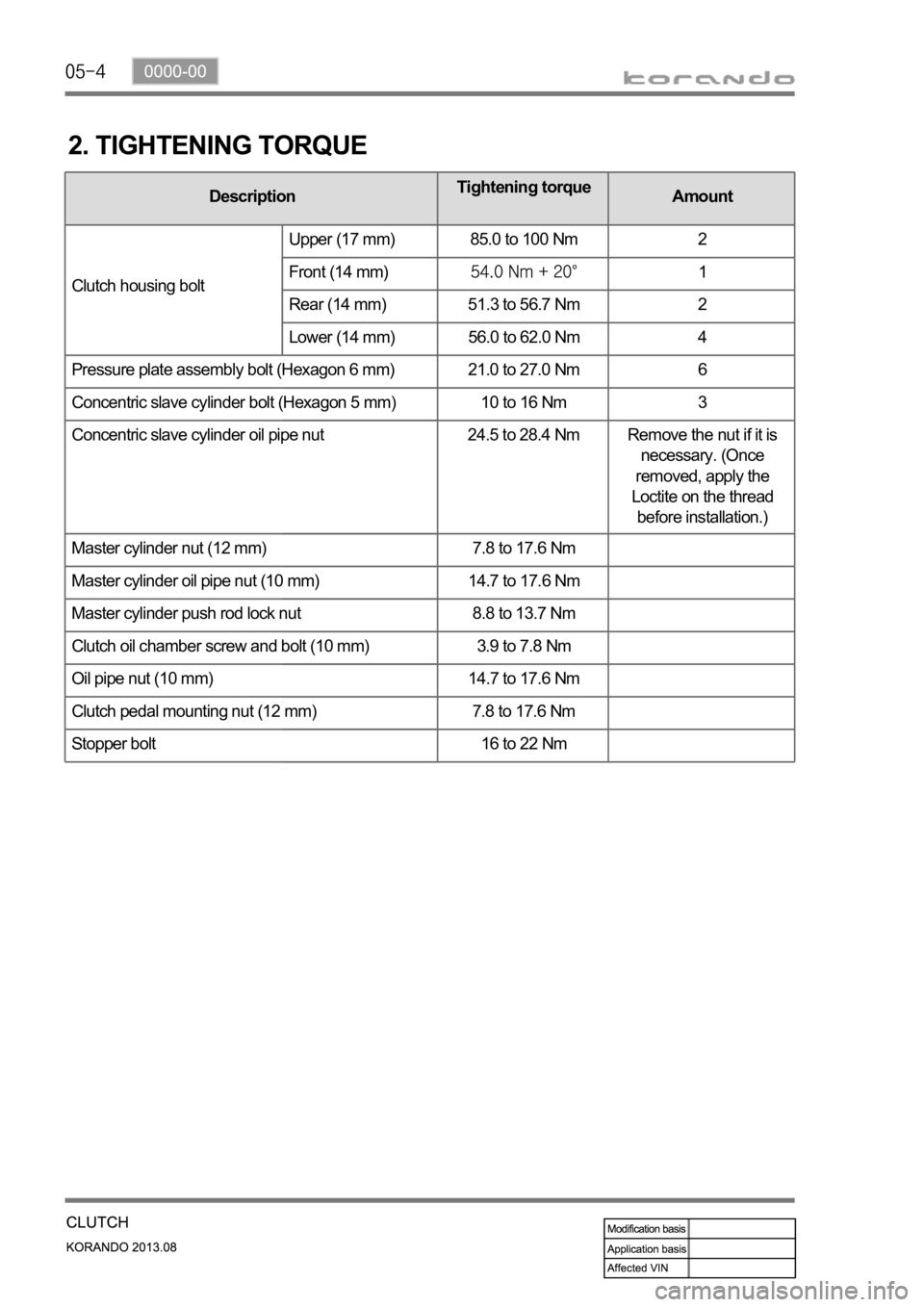
2. TIGHTENING TORQUE
DescriptionTightening torque
Amount
Clutch housing boltUpper (17 mm) 85.0 to 100 Nm 2
Front (14 mm)
1
Rear (14 mm) 51.3 to 56.7 Nm 2
Lower (14 mm) 56.0 to 62.0 Nm 4
Pressure plate assembly bolt (Hexagon 6 mm) 21.0 to 27.0 Nm 6
Concentric slave cylinder bolt (Hexagon 5 mm) 10 to 16 Nm 3
Concentric slave cylinder oil pipe nut 24.5 to 28.4 Nm Remove the nut if it is
necessary. (Once
removed, apply the
Loctite on the thread
before installation.)
Master cylinder nut (12 mm) 7.8 to 17.6 Nm
Master cylinder oil pipe nut (10 mm) 14.7 to 17.6 Nm
Master cylinder push rod lock nut 8.8 to 13.7 Nm
Clutch oil chamber screw and bolt (10 mm) 3.9 to 7.8 Nm
Oil pipe nut (10 mm) 14.7 to 17.6 Nm
Clutch pedal mounting nut (12 mm) 7.8 to 17.6 Nm
Stopper bolt 16 to 22 Nm
Page 1073 of 1336
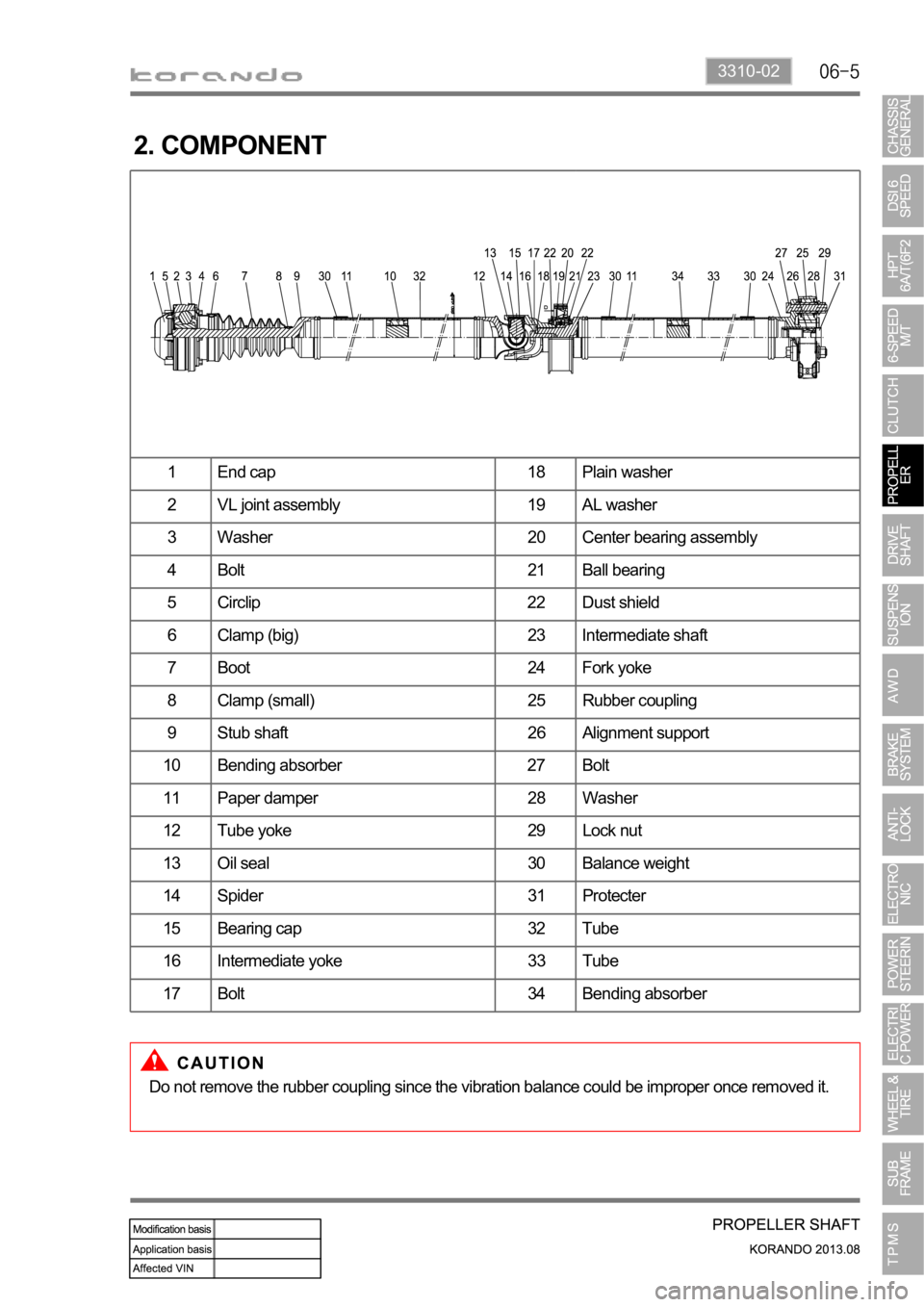
3310-02
2. COMPONENT
1 End cap 18 Plain washer
2 VL joint assembly 19 AL washer
3 Washer 20 Center bearing assembly
4 Bolt 21 Ball bearing
5 Circlip 22 Dust shield
6 Clamp (big) 23 Intermediate shaft
7 Boot 24 Fork yoke
8 Clamp (small) 25 Rubber coupling
9 Stub shaft 26 Alignment support
10 Bending absorber 27 Bolt
11 Paper damper 28 Washer
12 Tube yoke 29 Lock nut
13 Oil seal 30 Balance weight
14 Spider 31 Protecter
15 Bearing cap 32 Tube
16 Intermediate yoke 33 Tube
17 Bolt 34 Bending absorber
Do not remove the rubber coupling since the vibration balance could be improper once removed it.
Page 1086 of 1336
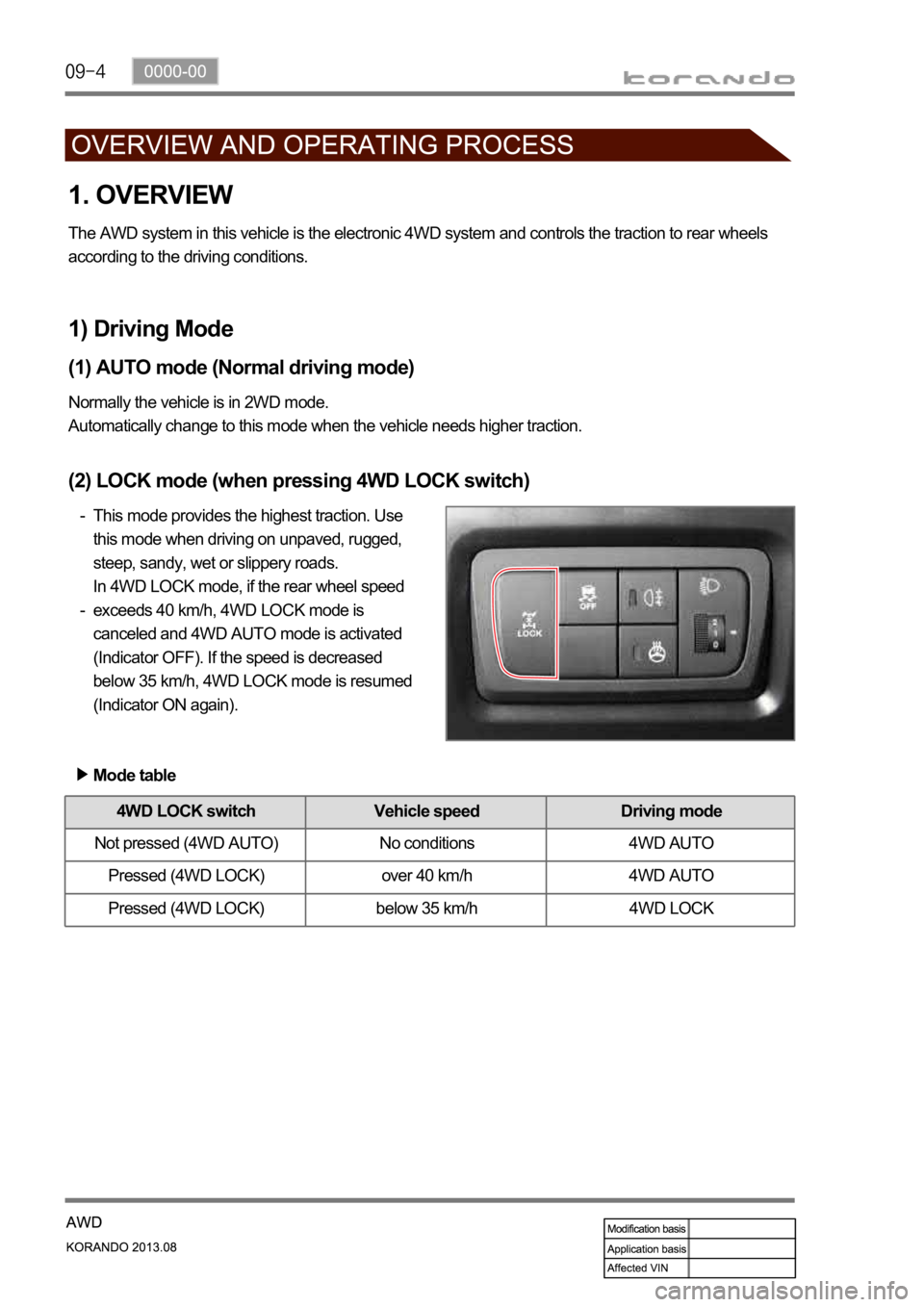
1. OVERVIEW
The AWD system in this vehicle is the electronic 4WD system and controls the traction to rear wheels
according to the driving conditions.
1) Driving Mode
(1) AUTO mode (Normal driving mode)
Normally the vehicle is in 2WD mode.
Automatically change to this mode when the vehicle needs higher traction.
(2) LOCK mode (when pressing 4WD LOCK switch)
This mode provides the highest traction. Use
this mode when driving on unpaved, rugged,
steep, sandy, wet or slippery roads.
In 4WD LOCK mode, if the rear wheel speed
exceeds 40 km/h, 4WD LOCK mode is
canceled and 4WD AUTO mode is activated
(Indicator OFF). If the speed is decreased
below 35 km/h, 4WD LOCK mode is resumed
(Indicator ON again). -
-
Mode table
4WD LOCK switch Vehicle speed Driving mode
Not pressed (4WD AUTO) No conditions 4WD AUTO
Pressed (4WD LOCK) over 40 km/h 4WD AUTO
Pressed (4WD LOCK) below 35 km/h 4WD LOCK
Page 1088 of 1336

4850-00
1. SYSTEM OVERVIEW
1) Terms and Definition
CBS: Conventional Brake System
ABS: Anti-Lock Brake System
EBD: Electronic brake-Force Distribution
ESP: Electronic Stability Program
ABD: Automatic Braking Differential
ASR: Acceleration Slip Regulation
AYC: Active Yaw Control (Understeer and Oversteer Control)
HBA: Hydraulic Brake Assistant
ARP: Active Rollover Protection
HSA: Hill Start Assistant -
-
-
-
-
-
-
-
-
-
2) Functions
FunctionVehicle with CBS
Vehicle with ABS/EBD Vehicle with ESP
ABS
Not appliedApplied
Applied EBD Applied
ABD
Not applied ASR
AYC
HBA
ARP
HSA
Page 1099 of 1336
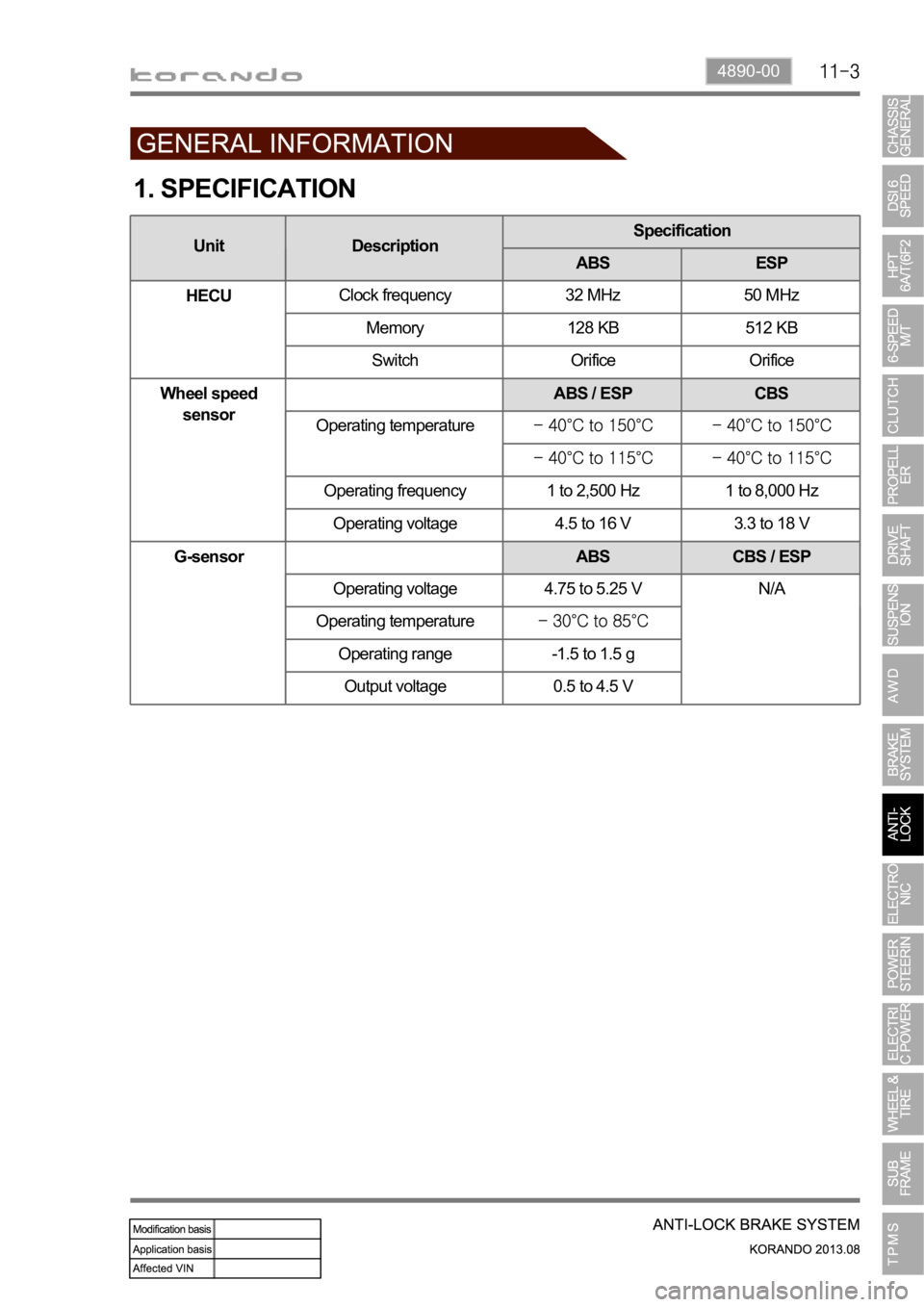
4890-00
1. SPECIFICATION
Unit DescriptionSpecification
ABS ESP
HECUClock frequency 32 MHz 50 MHz
Memory 128 KB 512 KB
Switch Orifice Orifice
Wheel speed
sensorABS / ESP CBS
Operating temperature
Operating frequency 1 to 2,500 Hz 1 to 8,000 Hz
Operating voltage 4.5 to 16 V 3.3 to 18 V
G-sensor ABS CBS / ESP
Operating voltage 4.75 to 5.25 V N/A
Operating temperature
Operating range -1.5 to 1.5 g
Output voltage 0.5 to 4.5 V
Page 1101 of 1336
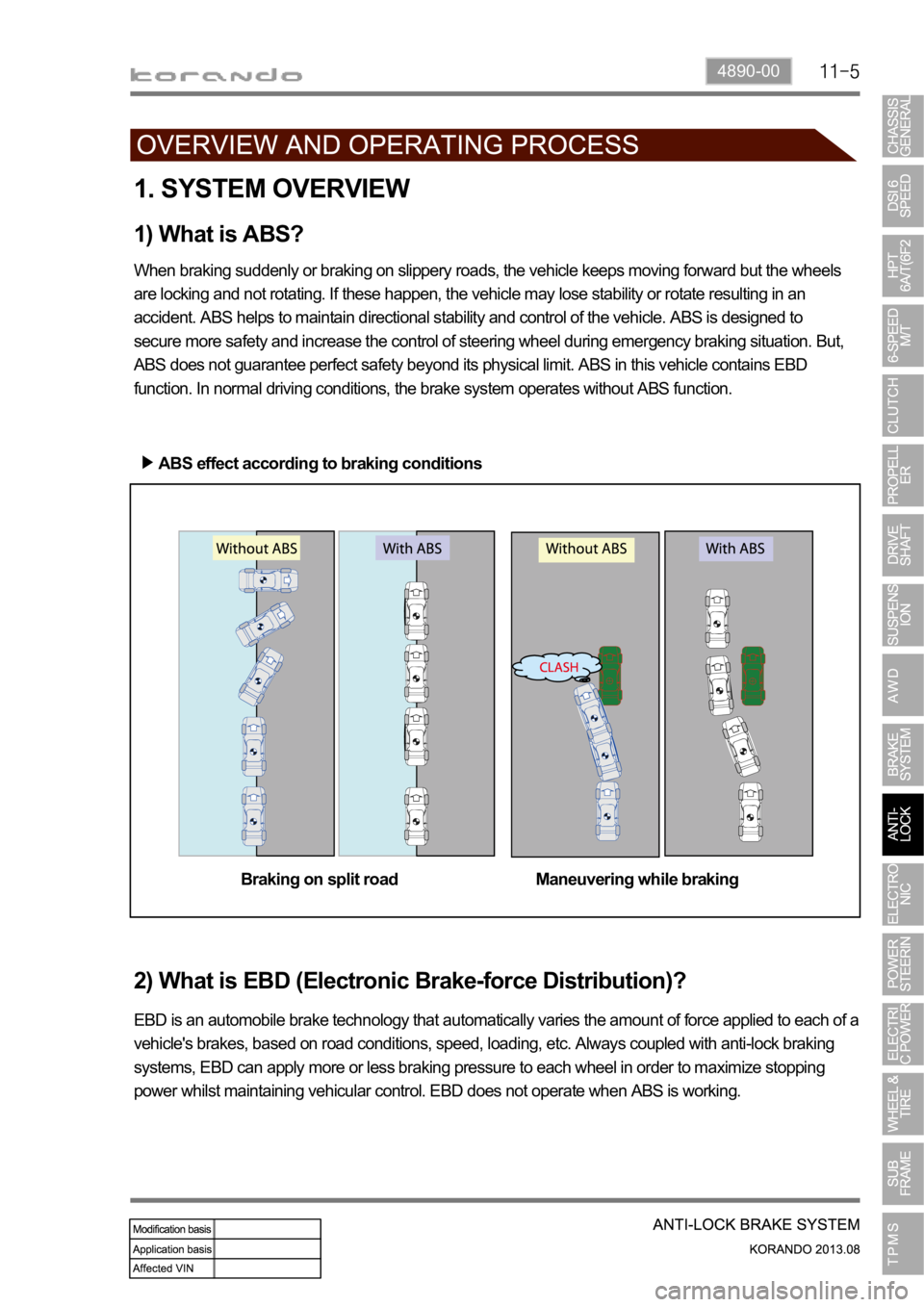
4890-00
1. SYSTEM OVERVIEW
1) What is ABS?
When braking suddenly or braking on slippery roads, the vehicle keeps moving forward but the wheels
are locking and not rotating. If these happen, the vehicle may lose stability or rotate resulting in an
accident. ABS helps to maintain directional stability and control of the vehicle. ABS is designed to
secure more safety and increase the control of steering wheel during emergency braking situation. But,
ABS does not guarantee perfect safety beyond its physical limit. ABS in this vehicle contains EBD
function. In normal driving conditions, the brake system operates without ABS function.
2) What is EBD (Electronic Brake-force Distribution)?
EBD is an automobile brake technology that automatically varies the amount of force applied to each of a
vehicle's brakes, based on road conditions, speed, loading, etc. Always coupled with anti-lock braking
systems, EBD can apply more or less braking pressure to each wheel in order to maximize stopping
power whilst maintaining vehicular control. EBD does not operate when ABS is working. ABS effect according to braking conditions
Braking on split road Maneuvering while braking
Page 1108 of 1336

5. SYSTEM OPERATION
1) Block Diagram of ABS HECU
Page 1109 of 1336

4890-00
2) Basic Theory of ABS Function
To give you a better understanding of the tasks and functions of ABS, we will first look at the physics
principles.
(1) Stopping distance
The stopping distance depends on the vehicle weight and initial speed when braking starts. This also
applies for vehicle with ABS, where ABS always tries to set an optimum brake force on each wheel. As
great forces are exerted between the tires and the carriageway when braking, even with ABS the wheels
may scream and rubber is left on the road. With an ABS skid mark one may be able to clearly recognize
the tire profile. The skid mark of an ABS vehicle does not however leave any hint of the speed of the
vehicle in the case of an accident, as it can only be clearly drawn at the start of braking.
(2) Brake force on a wheel
The maximum possible brake force on a wheel depends on the wheel load and the adhesion coefficient
between tire and carriageway. With a low adhesion coefficient the brake force, which can be obtained is
very low. You are bound to know the result already from driving on winter roads. With a high adhesion
coefficient on a dry road, the brake force, which can be obtained, is considerably higher. The brake
force, which can be obtained, can be calculated from below formula:
Maximum brake force
FBmax = wheel load FR x coefficient of frictionMh
The braking process cannot be described sufficiently
accurately with the brake forces calculated. The
values calculated only apply if the wheel is not locked.
In the case of a locking wheel, the static friction turns
into lower sliding friction, with the result that the
stopping distance is increased. This loss of friction is
termed "slip" in specialist literature.
Page 1110 of 1336

Slip
The brake slip is the difference between the vehicle speed and the wheel circumference speed. If the
wheel locks, the slip is greatest, that is 100 %. If the wheel is running freely and un-braked, the slip is the
lowest, equal to 0 %. Slip can be calculated from the vehicle speed Vveh and the wheel speed Vw. The
equation for this is:
Vveh = 100 km/h, Vw = 70 km/h
Slip ratio (S) =
For the various road conditions, the friction
coefficients were plotted. The typical course of
the curves is always the same. The only special
feature is shown by the curve for freshly fallen
snow, for this curve increases at 100 % slip. In a
vehicle without ABS, the wheel locks on braking
and therefore pushes a wedge before it. This
wedge of loose surface or freshly fallen snow
means and increased resistance and as a result
the stopping distance is shorter. This reduction in
stopping distance is not possible with a vehicle
with ABS, as the wheel does not lock. On these
surfaces the stopping distance with ABS is
longer than without ABS. The reason for this is
based in physics and not in the Anti-Lock
System.
However, as mentioned before, ABS is not about
the stopping distance, but maneuverability and
driving stability, for the vehicle with locking
wheels without ABS cannot be steered. Typical Slip Curves
Vveh - Vw
VvehX 100%
S = 30%
Page 1111 of 1336
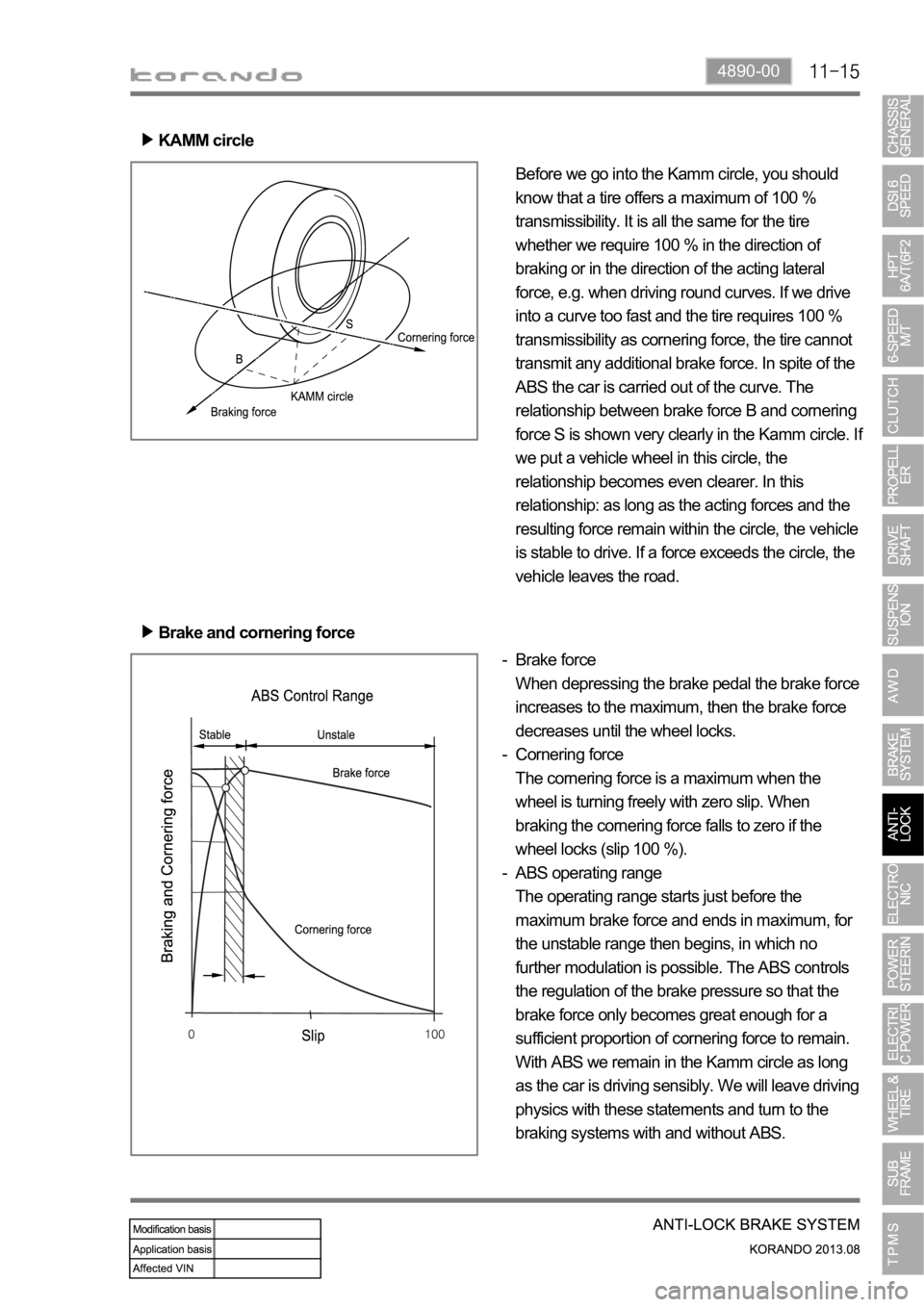
4890-00
KAMM circle
Before we go into the Kamm circle, you should
know that a tire offers a maximum of 100 %
transmissibility. It is all the same for the tire
whether we require 100 % in the direction of
braking or in the direction of the acting lateral
force, e.g. when driving round curves. If we drive
into a curve too fast and the tire requires 100 %
transmissibility as cornering force, the tire cannot
transmit any additional brake force. In spite of the
ABS the car is carried out of the curve. The
relationship between brake force B and cornering
force S is shown very clearly in the Kamm circle. I
f
we put a vehicle wheel in this circle, the
relationship becomes even clearer. In this
relationship: as long as the acting forces and the
resulting force remain within the circle, the vehicle
is stable to drive. If a force exceeds the circle, the
vehicle leaves the road.
Brake force
When depressing the brake pedal the brake force
increases to the maximum, then the brake force
decreases until the wheel locks.
Cornering force
The cornering force is a maximum when the
wheel is turning freely with zero slip. When
braking the cornering force falls to zero if the
wheel locks (slip 100 %).
ABS operating range
The operating range starts just before the
maximum brake force and ends in maximum, for
the unstable range then begins, in which no
further modulation is possible. The ABS controls
the regulation of the brake pressure so that the
brake force only becomes great enough for a
sufficient proportion of cornering force to remain.
With ABS we remain in the Kamm circle as long
as the car is driving sensibly. We will leave driving
physics with these statements and turn to the
braking systems with and without ABS. -
-
- Brake and cornering force